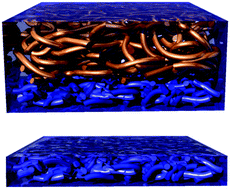Electrical characteristics of heterogeneous polymer layers in PEDOT:PSS films
Abstract
(3,4-Ethylenedioxythiophene):poly(styrenesulfonate) (PEDOT:PSS), a representative conducting polymer, is environment-friendly and offers easy processing and flexibility owing to its hydro-dispersive properties. In this study, we investigated the electrical properties of PEDOT:PSS films with H2SO4/DMSO post-treatment. PEDOT:PSS is an electrolyte complex that has been attracting attention as a next-generation transparent electrode. The PEDOT:PSS films are composed of two heterogeneous phases: a PSS-rich layer and a PEDOT-rich layer. The PSS-rich layer is observed to be a homogeneous phase that does not influence the electrical properties. Thus, the PSS-rich layer, which occupies a large area of the PEDOT:PSS films, was removed to obtain films having high electrical properties. Both the layers exhibit a homogeneous phase regardless of their electrical properties. In particular, the PSS-rich layer without the PEDOT chains does not affect the electrical properties, since it does not contribute to hole transport. The heterogeneity of the PEDOT:PSS films with good electrical properties has been revealed by eliminating the unnecessary PSS-rich layers. The highest electrical conductivity obtained was 2239 S cm−1, which is about 4.1 times higher than that of the pristine PEDOT:PSS films, for the films involving 15 M H2SO4/DMSO post-treatment.



 Please wait while we load your content...
Please wait while we load your content...